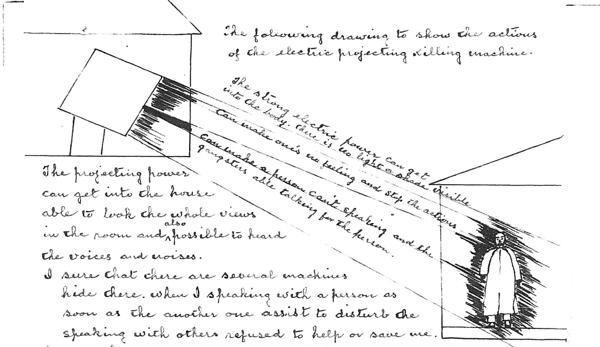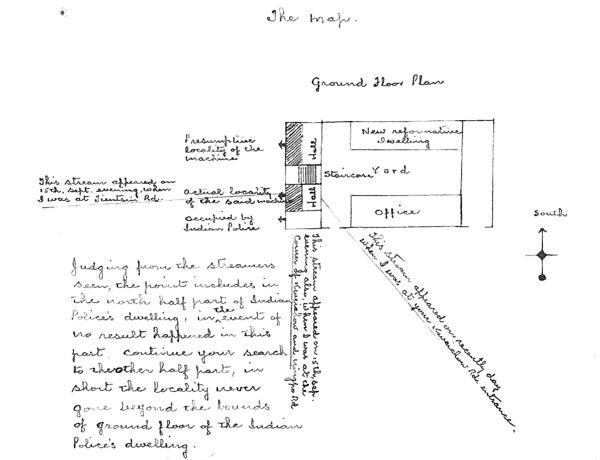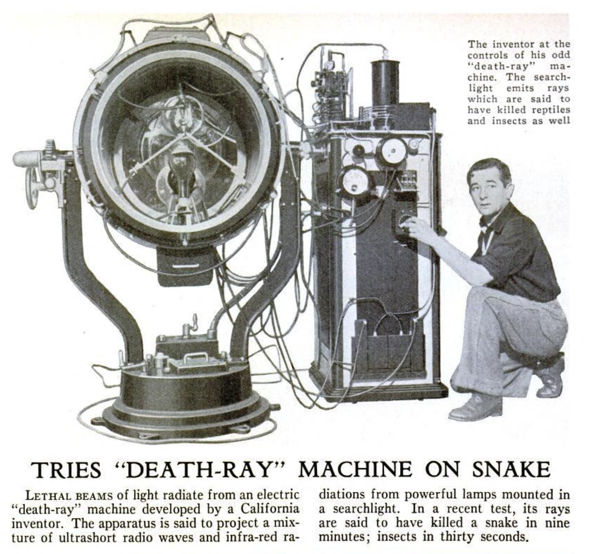
In May, 1939, while the Japanese military controlled the Chinese parts of the city, an “urgent report” was sent to the Louza Police Station (Laozha 老閘) in the International Settlement: “An appeal for your searching investigation of ‘Electric Projecting Killing Machine’”.
Supposed location of the said machine: It is said that in your Foreign Staff quarters of your Police Station. And it is further stated that the location of the said machine lies in the upper story east and north corner of the foreign staff square. Moreover it is heard that there are voices of more than eight or nine Chinese men and boy heard there. The voices of the men & boy are to be heard both day & night. That machine follow me estimate more than thirty years owing it can state my youthold story, the holder are all of your room boys I believe.
That machine is said to be a rarity in Shanghai, the projecting power is very strong, though there is no light or shade visible. It can kill any body’s life as soon as the projecting power gets in touch with him or her wherever one is on the boat or sleeping indoors or going outdoors no matter how far the distance is. To sum up it has the following killing powers:
It can get into human body and destroy the organs.
It can make every body abnormal and kill one
It can make his or her strains in their body feel inclined to drown in the water for death.
It can transmit words through another man’s mouth in order to disturb speaking of others.
It can make one’s intelligence fly away and become a stupid and no-minded person of usefulness.
It can make film picture at a long distance and project its harmful power into human body in order to cripple one’s mind and actions.
It can projecting the noise and voice to long distance
It is said that the machine can make one walk and feel nothing particular after he or she has not taken anything or slept or drunk etc. for more than a week or few days. It can in other hand, however, still one immediately without allowing anybody to help or save him…
…My third daughter has died of the effect of the machine…my fourth daughter is nearly suffered to death on account of the effect of the machine. Most of my family members have more or less received harmful effects of the said machine…
…As it is the duty of your police to maintain peace and safety of the community, so I firmly request you to investigate and search carefully the machine in the foreign staff quarters…as the machine is concealed and carefully hidden there…
The report came from a Chinese man, a Mr. Sung/Seng/Sun (孫) living in a refugee camp dormitory attached to the Yufo temple (玉佛寺 Jade Buddha Temple) on Penang Road (now Anyuan lu 安远路) and is preserved in a 45 page Shanghai Municipal Police file. This file contains over twenty more similar letters, in the same neat handwriting or typed with its distinctive mix of alternating eloquent and awkward English phrasing. All were sent to the Louza station between 1939 and February, 1941, with the same urgent request for the police to investigate a dangerous hidden “Electric Projecting Killing Machine” believed to be located in the station’s grounds.
A Special Branch police report on the letter’s author, dated 19 May, 1939, describes the mental health challenges of the 35 year old from Pudong, said to be suffering from “partial mental derangement.” He apparently worked as a clerk for the American Asiatic Underwriters company (17 The Bund) for some eight years, when “he suddenly became mentally unbalanced” at the end of 1936. A few months later he was discharged. The report, written by one D.S.I. Liao Chung Chian, concludes by noting that a cousin of the affected man says that the “mental disease is not really serious and in fact for many hours during a day his condition is normal.”
In addition to the early report, there are two police replies included with the file.1 The first reply in June, 1940 says “The subject of your complaint has been thoroughly investigated without result, and I have to inform you that no further action can be taken in the matter” with a handwritten note, “Delivered by chit-book. I hope it will stop him.” A second and last reply in the file from the Divisional Officer, “A” Division, in August, says “I am satisfied that no such machine exists in Louza Police Station, therefore no further correspondence will be entertained.” Eight more letters will make their way into the file.
A few things about this case strike me. One is to once again marvel at the diversity of lived experiences to be found in these SMP police documents (browse an index of open access copies of them I’m working on here), even if they privilege an often problematic policeman’s gaze. Even when we get rich accounts from independent sources, as with these letters, they only allow us to read whatever was preserved by the police, and then later by the American OSS, which ended up with copies of some of the SMP files that, in turn, were preserved in the US National Archives CIA records (RG 263).

I am also drawn to the level of elaborate detail in the appeals of Mr. Sung (as he signs his letters). His death ray is equipped with far more than the usual lethal powers of the genre. In two letters he includes a dramatic illustration of the killing machine beaming its ray (see the first image in this post for one of them), while in several others he offers increasingly detailed drawings of the supposed location.2 In his early letters he appears to believe the machine is under the operation of a number of Chinese gangsters and a boy, or coolie, or servant operating out of a special room for the machine’s use. Later he will merely say that the “murderers” are hiding in the “Indian Police’s dwelling.” Louza station was predominantly staffed by a mixed force of Chinese and Sikh officers and a few Europeans but, despite the fact the latter were often depicted in unflattering terms by Chinese residents, I didn’t see anything detrimental said about either them or any of the police in Mr. Sung’s many letters.3

The centrality of the death ray in this man’s paranoid letters is a strikingly global feature of the case. Though H.G. Wells has a heat ray in The War of the Worlds (1898), William Fanning has argued that the 1920s and 1930s were the high point for interest in the idea of a killing ray in both fiction and supposedly non-fiction contexts.4 There are plenty of sources across these two decades that might have inspired Mr. Sung. Working as he was at an American company on the Bund, I imagine him picking up a copy of the August, 1936 issue of Popular Science in his work place, where he could have seen a depiction (displayed here) of a machine that bears a striking resemblance to one of his drawings. It is at the end of that year that his condition was said to have emerged.
One thing that puzzles me somewhat, however, is the fact that Mr. Sung is writing this stream of letters to a police station that is almost an hour walk away from his own place of residence. His temple is located in the western part of the international settlement inside the “Pootoo” police district. Even if he ignored the police station in his own area, walking towards Louza police station he would pass through the districts of two other police stations (Gordon and Sinza).
 Why does he believe the electric projecting killing machine is in a station at some distance from himself? His letters often describe his reconnaissance efforts around the station, to pinpoint the exact location of the ray. It is possible, of course, that he has been writing these letters to several stations, and these are the only ones that got preserved in his file, and I suspect we will never know for sure. Perhaps it is just the centrality of the station, located as it is just off Nanking Road, or perhaps its historical infamy. The police station is known for one of the darker moments in Shanghai history, the May 30 incident, or “Shanghai massacre” of 1925 triggering the movement of that name (五卅运动). On that day, police officers of Louza police station opened fire on a crowd of protesters, killing several of them and sparking widespread anti-foreign strikes and boycotts around China. If this had something to do with it, however, it is notable that the neither the police themselves nor foreigners are depicted as the villains behind Mr. Sung’s killing machine.
Why does he believe the electric projecting killing machine is in a station at some distance from himself? His letters often describe his reconnaissance efforts around the station, to pinpoint the exact location of the ray. It is possible, of course, that he has been writing these letters to several stations, and these are the only ones that got preserved in his file, and I suspect we will never know for sure. Perhaps it is just the centrality of the station, located as it is just off Nanking Road, or perhaps its historical infamy. The police station is known for one of the darker moments in Shanghai history, the May 30 incident, or “Shanghai massacre” of 1925 triggering the movement of that name (五卅运动). On that day, police officers of Louza police station opened fire on a crowd of protesters, killing several of them and sparking widespread anti-foreign strikes and boycotts around China. If this had something to do with it, however, it is notable that the neither the police themselves nor foreigners are depicted as the villains behind Mr. Sung’s killing machine.
There is one more interesting connection between the idea of a death ray, the Louza station and the May 30 movement to be found in Richard W. Rigby’s history of the May 30 Movement. While I have not yet been able to track down the citation5 and read the original source, Rigby describes a story published in a memorial issue recalling the events of May 30, 1925:
The story, ‘The Light of China’, tells of a young man who shuts himself off from the world for ten long years, working on a project to avenge his fallen comrades. He successfully invents and perfects an electric ray, and on 30 May 1935 he emerges from his seclusion to turn it on the foreigners in Shanghai, leaving their persons unharmed but completely destroying all their weapons and warships. Before long, China’s new secret having been made known, the whole world is disarmed and a world government devoted to universal peace and harmony rules from Shanghai. Only Japan, refusing to face reality, stubbornly attempts an invasion, is of course defeated, and her premier publicly scolded. This achieved, our hero departs on his honeymoon, observing that it had all been made possible by science and organization.6
It is hard to see how the above rather optimistic plot, and the relatively benign effects of the story’s ray have much in common with Mr. Sung’s imagined insidious gangster ray, but it is evidence that ideas about electric rays in Shanghai were in the mind of more than one person. Perhaps it is this Chinese language story, and not Popular Science or any other international sources that is the immediate inspiration for Mr. Sung ideas around a powerful ray? Or perhaps Mr. Sung was, in fact, right all along? Perhaps operatives of the Green Gang, with their deep police ties were indeed operating a powerful killing machine out of the convenient central location of the Louza Police Station? Special branch may have buried Mr. Sung’s letters deep in their files, but we can only hope a Netflix special will someday bring the truth of this conspiracy back into the light. 😊
p24 and p28 of the file. https://archive.org/details/smpa-files-361 ↩
p17 and p32 of the file for the drawings, and p7, p9, p13, p19, and p21 for his maps. ↩
For more on Sikh police officers see Isabella Jackson. ‘The Raj on Nanjing Road: Sikh Policemen in Treaty-Port Shanghai’. Modern Asian Studies 46, no. 06 (2012): 1672–1704. Cao, Yin. From Policemen to Revolutionaries: A Sikh Diaspora in Global Shanghai, 1885-1945. BRILL, 2017. ↩
Fanning, William J. ‘The Historical Death Ray and Science Fiction in the 1920s and 1930s’. Science Fiction Studies 37, no. 2 (2010), 253. ↩
Rigby cites Tu-li P’ing-lun no 10, May 30 memorial issue, 30/5/26; pp. 11-14 ↩
Emphasis mine. I only have Rigby’s 1975 dissertation at hand “The May 30 Movement: an Outline” Australian National University, pp316-7. However, google books suggests that the anecdote is also included in his book The May 30 Movement: Events and Themes, p164. ↩
Always a pleasure to find out what the hard-working boys in blue had to deal with. 🙂 For what its worth, I instantly thought about airplanes reading this. The idea that there might be super-weapons was of course not that odd after WWI, and while the idea that they might be targeted at random civilians seems odd to us it was pretty generally accepted that poison gas would be dropped on civilians from the air in the “next war”. In fact, the Japanese and Brits did some of that in the interwar period, but for some reason it never did happen on a large scale in WWII.
Fascinating stuff. One of the references I stumbled across regarding the death ray and aircraft was this 1924 Popular Mechanics article on using a ray to bring down aircraft. Nowadays, similar tech being explored for the taking down of drowns with lasers or some such:
https://books.google.co.uk/books?id=4toDAAAAMBAJ&pg=PA189&dq=%22death+ray%22&hl=en&sa=X&ved=2ahUKEwjl69vH8JuFAxWSWEEAHUKYDK4Q6AF6BAgEEAI#v=onepage&q=%22death%20ray%22&f=false